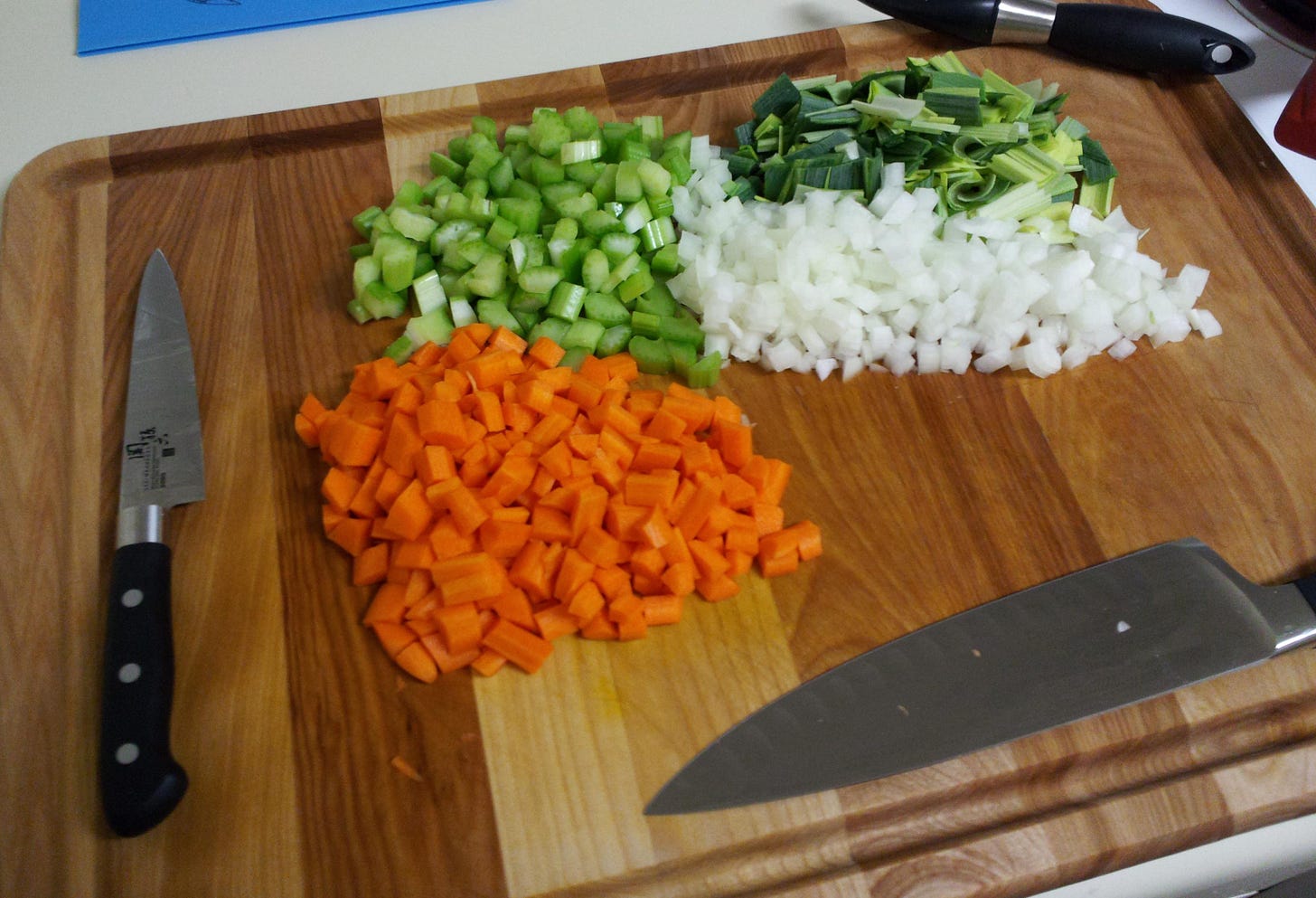Mirepoix
The foundation of the foundation.
Shorter post this week for two reasons. First, we only had one class (due to the short holiday week). Second, I left immediately after for a work trip all week and only just returned, so had less time. So, on to the update…
When you start moving away from simply following recipes, the first mindset shift involves seeing a dish as a collection of components. Not ingredients… components.
Components are elements of a dish that serve the same purpose, but may contain different ingredients. Different ingredients, but same function. When you’re following recipes, better to read between the lines in the list of ingredients, and start to focus on their function when combined into components.
Doing so breaks the recipe and dish into smaller, easier to remember chunks. It’s like remembering phone numbers by breaking them into three sections of numbers (area code - prefix - local exchange) rather than remembering 10 individual numbers.
Memory aside, it also better sets you up for understanding how a dish is composed.
For instance a sauce, a soup, a risotto and a pan sauce all use the similar set of components:
Mirepoix (base)
Aromatics (spices)
Deglazing Liquid (wine or water)
Primary Liquid (water or stock)
Primary Ingredient (protein and/or vegetables)
Finishing Balance (salt, acid, fat)
Understanding the ingredients that go into each component, and the purpose of each, will allow you to mix and match ingredients at will with whatever you have on hand, making for easier creation of your own dish, or modifications of any recipe you’ll follow.
Since I’m short on time today, let’s just focus on the first component as an example… mirepoix.
Ratio
The basic ratio of a classic mirepoix is
2 parts onion (almost always yellow)
1 part celery
1 part carrot
How much of each ingredient depends on how much of the mirepoix component you need, which in turn is determined by the volume of the overall dish. For instance, for chicken stock you might use 1 part mirepoix to 3 part bones (by weight).
(by the way… I’ve gotten these ratios wrong for YEARS.)
Ingredients
Why these specific ingredients? What does each ingredient add to the overall component of mirepoix? It’s a question I honestly never thought to ask until Chef John raised it in class last week.
Onions: contribute sweetness and act as a natural thickener
Carrots: contribute sweetness as well, as well as color and brightness
Celery: contribute sodium and a hint of bitterness/herbaceousness to balance the sweetness of the onions and carrots
Together, they become more than the sum of their parts and create the component of mirepoix. Their flavors combine into something new and different.
There are also more practical reasons for this specific combination. All are easy to grow and store. By that I mean they have long growing seasons that apply to the climate of most regions worldwide, and they don’t go bad quickly. In other words… they’re easily available.
Beyond that, they all cook at about the same rate, and they naturally contain good bacteria that contribute to good gut health and digestion.
Preparation
First, you have to cut all ingredients to the same size. What size? Depends on the use:
Saute or stir fry = small dice (⅛ - ¼ inch pieces)
Stews and soups = medium dice (½ inch pieces)
Stocks and broths = large dice (1 - 2 inch pieces)
Then simply soften the ingredients in fat (butter or oil) with some salt at a low heat to “sweat” them (drawing out their liquid/sugars) until soft and translucent. For certain stocks/sauces, you may go as far as to brown or caramelize them.
Variations
As a component, there can of course be substitutions for each ingredient, such as leeks instead of onions, parsnips instead of carrots, or celery root (celeriac) instead of celery. But typically the variations are based on cuisine.
Classic mirepoix is French. Other mirepoix-like variations result in the same component, but with slightly different ingredients (and underlying flavor profiles).
Sofrito (Spain): Onions, tomatoes, bell peppers and garlic
Battuto (Italy): Onion, celery, carrot, garlic, and sometimes fennel and/or parsley. The vegetables are minced (i.e.: more finely cut than diced) and always fried in olive oil.
Cajun Holy Trinity (U.S.): onion, celery and green bell pepper.
Chinese Holy Trinity (China): scallions, ginger and garlic (sometimes chilies)
You get the idea.
Purpose
The purpose of a mirepoix is to create a base of flavor. As specific ingredients, their individual tastes and textures will vanish to the background of the resulting dish to the point you wouldn’t even know they were there. Like my old band conductor used to say about the tuba: it should be felt, not heard. The flavor blends or melts into the rest of the dish.
Use
From stocks, to soups, to sautees, to stews, to stir fries and so much more, mirepoix is nearly always “step 1.” To give you a sense of how foundational mirepoix is in cooking, consider this… The classic French culinary tradition calls stocks the “fond de cuisine” or “foundation of cuisine.”
What’s the first step in making a stock? Mirepoix.
So if you don’t have onions, carrots and celery as part of your go-to shopping list to have on hand at ALL times in your kitchen, time to start. When you begin cooking by component, and less by recipe, it’s hard to imagine a more fundamental, foundational, and necessary component than the classic mirepoix.


